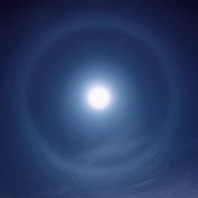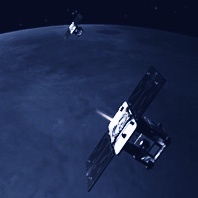Tag:
Science
Who believes to see a staggering Moon at night, has probably had a drop too much, although a staggering movement of the Moon actually exists in astronomy. This is called »libration«, but happens very slowly and is therefore only visible by the naked eye in time-lapse photography.
The Moon orbits around the Earth in a so called synchronous rotation. This means that it always faces one hemisphere towards the Earth, while the reverse side of the Moon is not visible from Earth. Due to certain physical conditions (relating to orbits, angular velocity, centres of mass, among others), what happens is that the visible surface of the Moon varies slightly during the course of the moon cycle, and there is a gentle change of inclination of the Moon’s axis or it appears to turn a little.
Read more
As already mentioned in our article about sleepwalking, a connection was made in the past between the moonlight and people, if their conduct was odd, crazy or threatening. One assumed that the moonlight caused this behaviour and spoke of “lunatic”, which derives from the Latin “lunatus” and means more or less “influenced by the moon”. In English, this terminology “lunatic” has been used for many forms of mental illnesses over many centuries. Because many of these disorders could not be explained for a long time (and there are still plenty of questions today), one was in need of a point of reference, a word that would accompany on the path of darkness. The Moon was very convenient.
Read more
Have you ever wondered, after you took a photograph of the full moon that the Moon looks much smaller on the picture than as it appears to you in real? This effect occurs particularly when the Moon is above the horizon. This is a so-called Moon illusion, which is an optical illusion, meaning it can only be seen this way through our perception and is therefore not depicted on the photograph.
Read more
The word “aggression” derives from the Latin verb “aggredi” which means »approach, attack«. This is interesting, because it does not only contain a destructive energy, but also a proceeding, solution-oriented energy. We also speak of tackling problems or approaching a task. During the course of the centuries, the component of attacking and destroying appears to have become dominant, so much so, that we judge aggression nowadays negatively and see the result to be destruction, violence and war. It is easily understandable now, why people are having such a difficult time to deal naturally with their aggressions that they express or restrain. We have put a negative mark on it. And we neither want to carry something negative inside us, nor do we want to voice it.
Read more
Sleepwalking is the term for a sleep disorder where the person concerned will move to an upright position in bed, or get up and walk around without waking up. It is also referred to as somnambulism, which derives from lat. »somnus« = sleep and »ambulare« = to wander. A further outdated term is »lunatism« and stems from the former belief that the light of the full moon coaxes the sleeper into leaving the bed. This misconception is scientifically disproved: sleepwalking takes place outside the lunar cycle.
Read more
We would like to turn our attention to two interesting types of light apparitions around the Moon: halos and coronas. Both are optical phenomena in the atmosphere that, if looked at from a physical point of view, come about in different ways and also look dissimilar.
A halo (left picture) develops through refracting ice crystals and creates a clearly defined light ring around the Sun or the Moon, whereas the surface between the celestial body and the ring, almost appears to be empty. Light spots, light arches and pillars can also emerge.
Read more
A probe is an unmanned flying object, which explores space. Different to a satellite, a probe does not circle the Earth but flies to other celestial bodies, which they circle, too, but are then called orbiters. Two of these probes have been on the way to the Moon since 10th September 2011, to take measurements with unprecedented accuracy. The GRAIL lunar probes have reached the orbit of the Moon as planned, at the turn of the year 2011/12 and are now currently at work, until they will shatter on the Moon’s surface. In the meantime, they will have transmitted lots of data back to Earth.
Read more
We have already reported about the subject “Sleeping at the full moon” with the insight that the phenomenon of a restless or bad sleep around the full moon apparently exists for many people, however, we are groping in the dark if looking at the background. Generally, skeptics claim that insufficient sleep is connected to the fact that the people concerned are more or less aware of it being a full moon and therefore eventuate a self-fulfilled prophecy. Those affected, counter that they often find out afterwards whether it was the full moon or it had not occurred to them yet to make this connection at all.
Read more
Moonlight is with only 1 lux brightness a thousand times weaker than the sun light with more than 100,000 lux. Nevertheless, you sometimes get the feeling that it is so bright in the full moon that you should be able to read. We would like to give this a try and invite all full moon friends to start on a small reading test in the full moon light and to report back the results.
Read more
Although, one could assume that the following concerns vampires or werewolves, we occupy ourselves with another kind of bite, namely the bite of animals to humans. There is a study of the E.R. department of the Bradford Royal Infirmatory in Bradford, England from 1997–1999. Here, the question, whether animals bite more often at the full moon, has been investigated. 1,621 patients were looked at, who had been treated for animal bites. The majority of affected patients had been bitten by dogs (95.1 %), others by cats (3.4 %), horses (0.8%) and rats (0.7 %). The surprising aspect of this study is, that indeed a significant connections could be detected between the full moon happenings and the animal bites. Hence, this should be the first study, known to us, which provides such a result!
Read more










